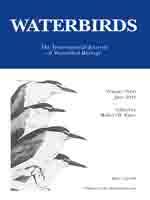Winter foraging ecology of Marbled Godwit (Limosa fedoa), Long-billed Curlew (Numenius americanus), Whimbrel (Numenius phaeopus) and Willet (Tringa semipalmata) was studied in relation to conspecific density at Estero de Urías, a tropical coastal lagoon in northwestern Mexico. Specifically, the effect of ecological factors in relation to individual prey capture rates for Marbled Godwits and both Numenius spp. was examined. There was a consistent, inverse relationship between conspecific density and foraging activity, but the slope differed among species. The inverse relationship suggests that conspecific density was an important determinant of individual foraging behavior and habitat use across species. For Marbled Godwits, prey capture rate was positively correlated with conspecific density and water depth, but negatively correlated with tidal height, at least during spring tides. In contrast, for both Numenius spp., prey capture rate was significantly higher for territorial birds and tactile foragers, in the case of Curlews, but was independent of tidal conditions. When neap tides resulted in reduced foraging time budget, Marbled Godwits increased prey capture rate, but Numenius spp., did not. Differences in foraging mode, availability of preferred prey in relation to water depth, as well as handling time of prey, could drive these distinct patterns between godwits and both Numenius spp. These results support suggestions that the increased conspecific density during periods of neap tides might explain the reduced prey capture rate of individuals with less competitive ability, especially within large shorebirds showing a sparse foraging distribution.
How to translate text using browser tools
1 June 2012
Foraging Activity and Capture Rate of Large Nearctic Shorebirds Wintering at a Tropical Coastal Lagoon
Juan G. Navedo,
Luis Sauma-Castillo,
Guillermo Fernández
ACCESS THE FULL ARTICLE

Waterbirds
Vol. 35 • No. 2
June 2012
Vol. 35 • No. 2
June 2012
coastal wetlands
foraging ecology
shorebird density
tides




